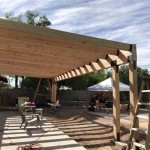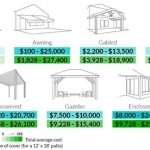How to Build a Cement Patio: A Comprehensive Guide
Constructing a cement patio can significantly enhance any outdoor living space, providing a durable and versatile area for relaxation, entertainment, and dining. This article provides a comprehensive guide to building a cement patio, outlining the necessary steps from initial planning and preparation to the final finishing touches. Successful execution requires careful attention to detail and adherence to proper techniques to ensure a structurally sound and aesthetically pleasing result.
Key Planning and Preparation Steps
The foundation of a successful cement patio project lies in thorough planning and meticulous preparation. This stage involves site assessment, design considerations, material selection, and acquiring necessary permits. Neglecting these initial steps can lead to complications and potentially compromise the project's longevity and structural integrity.
Site Assessment and Design: Before commencing any actual construction, carefully evaluate the proposed patio location. Consider factors such as drainage, sunlight exposure, and proximity to existing structures. Proper drainage is crucial to prevent water accumulation, which can lead to cracking and erosion of the cement. Observe the natural slope of the land and determine if any adjustments are necessary to ensure water runoff away from the patio and surrounding buildings. Analyze the amount of sunlight the area receives daily to inform decisions about shading options and potential plant selections. The patio design should integrate seamlessly with the existing landscape and architectural style of the property. Consider the intended use of the patio to determine its size and shape. A larger patio may be required for extensive entertaining, while a smaller patio might suffice for a more intimate seating arrangement. Sketching a detailed design, including dimensions and layout, is highly recommended.
Material Selection and Quantity Estimation: Selecting the appropriate materials is paramount to the patio's durability and aesthetic appeal. Portland cement is the primary ingredient in concrete and should be of high quality. The aggregate, which typically consists of gravel and sand, should be well-graded to ensure a strong and stable concrete mix. Determine the required quantity of cement, aggregate, and water based on the patio's dimensions and desired concrete thickness. A standard concrete thickness for patios is typically between 4 and 6 inches. Accurate calculations are essential to avoid material shortages or excesses, which can lead to project delays and increased costs. Consider purchasing a concrete mix from a reputable supplier to ensure consistent quality and proper proportions.
Permitting and Regulations: Before commencing any construction activity, it is imperative to investigate local building codes and regulations. Many municipalities require permits for concrete patios, especially if they exceed a certain size or involve alterations to existing drainage systems. Obtaining the necessary permits can prevent costly fines and delays. Contact the local building department to inquire about specific requirements and application procedures. Compliance with local regulations ensures that the patio meets safety standards and does not violate any zoning ordinances.
Tool and Equipment Acquisition: Assemble all necessary tools and equipment before starting the construction process. Essential tools include a shovel, rake, wheelbarrow, measuring tape, level, tamper, concrete mixer (or access to ready-mix concrete), floats, trowels, edger, groover, and safety glasses. Ensure that all equipment is in good working condition to minimize delays and potential accidents. Renting specialized equipment, such as a concrete mixer or plate compactor, may be a cost-effective option if these tools are not readily available.
Excavation, Forms, and Base Preparation
Preparing the site is crucial for ensuring a stable and level foundation for the cement patio. This involves excavation, form construction, and base preparation, all of which contribute to the patio's long-term structural integrity.
Excavation: Excavate the area designated for the patio to the desired depth, typically 6 to 8 inches below the finished grade. This depth allows for a 4-inch gravel base and a 4- to 6-inch concrete slab. Use a shovel and rake to remove all vegetation, topsoil, and debris from the area. Ensure that the excavated area is level and consistent in depth. Use a level and measuring tape to verify the accuracy of the excavation. A uniform depth is critical for creating a consistent concrete thickness and preventing uneven settling.
Form Construction: Construct forms around the perimeter of the excavated area to contain the wet concrete. Use lumber, such as 2x4s or 2x6s, to create the forms. The height of the forms should match the desired thickness of the concrete slab. Ensure that the forms are securely staked in place to prevent them from shifting or bowing during the concrete pouring process. Use a level to ensure that the forms are perfectly level, as this will directly affect the finished grade of the patio. Any irregularities in the form height will result in an uneven patio surface.
Base Preparation: After the forms are in place, create a stable base by adding a layer of compacted gravel. A 4-inch layer of crushed gravel provides excellent drainage and support for the concrete slab. Spread the gravel evenly over the excavated area and use a rake to ensure a uniform thickness. Compact the gravel using a hand tamper or plate compactor. Compaction is essential to create a solid and stable base that will prevent the concrete from settling and cracking. A well-compacted base also improves drainage by allowing water to flow freely beneath the concrete slab.
Reinforcement (Optional): Consider adding reinforcement to the concrete slab, especially for larger patios or areas with heavy foot traffic. Reinforcement can be achieved using wire mesh or rebar. Wire mesh is a grid of interconnected wires that is placed within the concrete to increase its tensile strength. Rebar consists of steel reinforcing bars that are strategically placed within the concrete to provide additional support. Reinforcement helps to distribute stress and prevent cracking in the concrete slab. Secure the wire mesh or rebar in place before pouring the concrete.
Mixing, Pouring, and Finishing Concrete
The process of mixing, pouring, and finishing concrete is critical for achieving a durable and aesthetically pleasing patio surface. Proper techniques are essential to ensure a smooth, level, and crack-resistant concrete slab.
Mixing Concrete: Mix the concrete according to the manufacturer's instructions, ensuring a consistent and workable consistency. Whether using a concrete mixer or ready-mix concrete, adhere to recommended water-to-cement ratios to achieve the desired strength and durability. Avoid adding excessive water, as this can weaken the concrete and increase the risk of cracking. If mixing concrete manually, ensure thorough mixing to achieve a uniform consistency. Ready-mix concrete provides a convenient and consistent option, but it is essential to coordinate delivery to ensure timely placement.
Pouring Concrete: Pour the concrete into the forms, starting at one corner and working across the area. Distribute the concrete evenly, using a shovel or rake to spread it into all corners and edges. Ensure that the concrete fills the forms completely and is level with the top of the forms. Use a come-along to consolidate the concrete and remove any air pockets. Consolidating the concrete ensures a denser and stronger slab. Avoid pouring concrete in extreme weather conditions, such as heavy rain or freezing temperatures, as this can negatively impact its curing process and strength.
Screeding: Use a screed board to level the concrete surface. A screed board is a long, straight piece of lumber that is dragged across the top of the forms to remove excess concrete and create a smooth, level surface. Rest the screed board on the forms and move it back and forth in a sawing motion to level the concrete. Ensure that the screed board is long enough to span the entire width of the patio. Repeat the screeding process as necessary to achieve a perfectly level surface.
Floating: After screeding, use a float to further smooth the concrete surface and consolidate the aggregate. A float is a flat tool, typically made of wood or magnesium, that is used to eliminate any remaining imperfections and create a uniform texture. Float the concrete surface in overlapping strokes, applying light pressure. Avoid over-floating, as this can weaken the surface of the concrete. Floating also helps to bring the cement paste to the surface, which is necessary for subsequent finishing steps.
Edging and Grooving: Use an edger to create rounded edges along the perimeter of the patio. An edger is a specialized tool that creates a smooth, rounded edge that prevents chipping and cracking. Run the edger along the inside of the forms, applying light pressure to create a uniform edge. Use a groover to create control joints in the concrete slab. Control joints are shallow cuts that are strategically placed in the concrete to control cracking. These joints create weak points in the concrete, allowing it to crack in a controlled manner along the joint rather than randomly across the surface. Space control joints evenly across the patio, typically every 8 to 10 feet.
Troweling: Troweling is the final step in finishing the concrete surface. Use a trowel to create a smooth, hard, and polished surface. A trowel is a flat, rectangular tool made of steel that is used to compact and smooth the concrete. Trowel the concrete surface in overlapping strokes, applying increasing pressure with each pass. The number of troweling passes will depend on the desired level of smoothness. Avoid over-troweling, as this can create a slippery surface. A broom finish can also be applied for added texture and slip resistance.
Curing and Sealing
Proper curing and sealing are essential to ensure the concrete patio's long-term durability and resistance to weathering. Curing involves maintaining moisture in the concrete to promote proper hydration and strength development. Sealing protects the concrete from water penetration, staining, and damage from freeze-thaw cycles.
Curing: Curing is the process of keeping the concrete moist for several days to allow it to hydrate properly and achieve its maximum strength. Start curing the concrete as soon as it has hardened sufficiently to prevent damage. Several methods can be used for curing, including covering the concrete with plastic sheeting, applying a curing compound, or continuously spraying the concrete with water. Plastic sheeting helps to retain moisture and prevent evaporation. Curing compounds are liquid coatings that seal the concrete surface and prevent moisture loss. Continuous spraying with water keeps the concrete moist and promotes hydration. Cure the concrete for at least 7 days, or longer in hot, dry weather.
Sealing: After the concrete has cured, apply a concrete sealer to protect it from water penetration, staining, and damage from freeze-thaw cycles. Choose a sealer that is specifically designed for concrete patios. Apply the sealer according to the manufacturer's instructions. Typically, this involves cleaning the concrete surface thoroughly and applying one or two coats of sealer using a roller or sprayer. Allow the sealer to dry completely before using the patio. Reapply the sealer every one to two years to maintain its protective properties.

Diy Concrete Patio In 8 Easy Steps How To Pour A Cement Slab

Quikrete Building A Concrete Patio

How To Plan Pour Your Diy Concrete Patio Liberty Ready Mix

Pouring Concrete Patio What Could Go Wrong With Doing It Yourself

How To Pour A Concrete Patio Learn About Pouring

How To Make A Nice Cement Patio Diy Concrete

Diy Concrete Patio How To Pour A Slab Bob Vila

Quikrete Building A Concrete Patio

Diy Concrete Patio How To Pour Your Own Slab Bn S

Diy Concrete Patio Makeover The Frugal South
Related Posts








